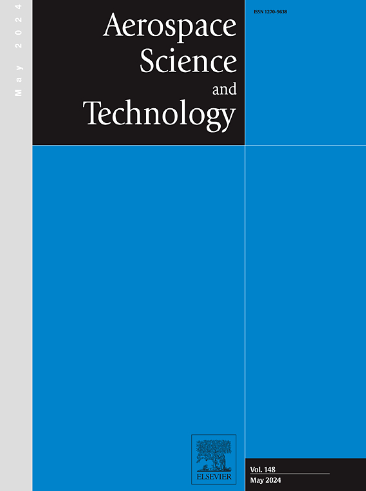带隔振系统的复合材料圆柱舱在超音速气流中的动力响应分析
IF 5
1区 工程技术
Q1 ENGINEERING, AEROSPACE
引用次数: 0
摘要
采用隔振系统对热气动环境下圆柱舱与板的内外振动传递性能进行了研究。采用一阶剪切变形理论(FSDT)建立理论模型,采用中心点虚拟弹簧法(CVSM)连接底板与圆柱舱。隔振系统根据运动关系与底板连接。利用活塞理论建立了气动环境,利用Hamilton变分原理和Jacobi微分正交法(JDQM)求解了耦合结构。通过与有限元法(FEM)比较圆柱舱室颤振以及耦合结构的频率、模态和动力响应,验证了该方法的准确性。此外,还确定了隔振系统的弹簧和阻尼值以及安装位置。在恒热条件和不同无因次气动压力下,研究了基板耦合位置和板厚比对耦合结构受迫振动的隔振动力响应,以期找到最优参数。本文章由计算机程序翻译,如有差异,请以英文原文为准。
Dynamic response analysis of the composite cylindrical cabin with vibration isolation system in supersonic airflow
This paper investigates the internal and external vibration transmission performance of the cylindrical cabin and plate with the vibration isolation system (CPIS) in the thermal aerodynamic environment. The theoretical model is established using the first order shear deformation theory (FSDT), and the center point virtual spring method (CVSM) is adopted to connect the base plate and the cylindrical cabin. The vibration isolation system is connected to the base plate based on the motion relationship. The aerodynamic environment is established by the piston theory, and the coupled structure is solved through Hamilton's variation principle and the Jacobi differential quadrature method (JDQM). The accuracy of this method is verified by comparing the cylindrical cabin flutter, as well as the frequencies, modes and dynamic responses of the coupled structure with the finite element method (FEM). Additionally, the spring and damping value of the vibration isolation system and the installation position are determined. The vibration isolation dynamic responses of the base plate coupling positions and plate thickness ratio to the forced vibration of the coupled structure are investigated under constant thermal conditions and different dimensionless aerodynamic pressures, in order to find the optimal parameter.
求助全文
通过发布文献求助,成功后即可免费获取论文全文。
去求助
来源期刊

Aerospace Science and Technology
工程技术-工程:宇航
CiteScore
10.30
自引率
28.60%
发文量
654
审稿时长
54 days
期刊介绍:
Aerospace Science and Technology publishes articles of outstanding scientific quality. Each article is reviewed by two referees. The journal welcomes papers from a wide range of countries. This journal publishes original papers, review articles and short communications related to all fields of aerospace research, fundamental and applied, potential applications of which are clearly related to:
• The design and the manufacture of aircraft, helicopters, missiles, launchers and satellites
• The control of their environment
• The study of various systems they are involved in, as supports or as targets.
Authors are invited to submit papers on new advances in the following topics to aerospace applications:
• Fluid dynamics
• Energetics and propulsion
• Materials and structures
• Flight mechanics
• Navigation, guidance and control
• Acoustics
• Optics
• Electromagnetism and radar
• Signal and image processing
• Information processing
• Data fusion
• Decision aid
• Human behaviour
• Robotics and intelligent systems
• Complex system engineering.
Etc.
 求助内容:
求助内容: 应助结果提醒方式:
应助结果提醒方式:


